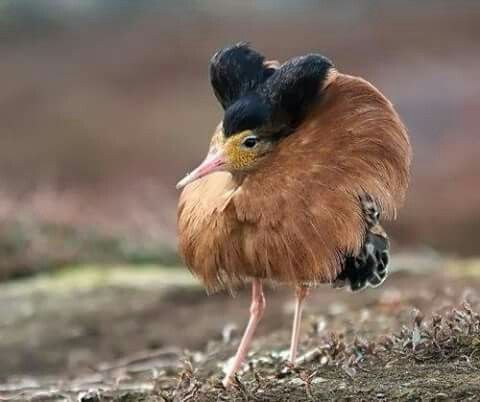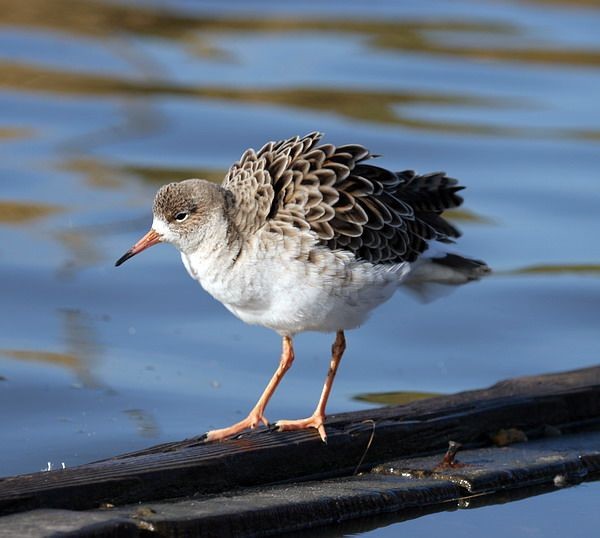Kingdom: Animalia
Phylum: Chordata
Class: Aves
Order: Charadriiformes
Family: Scolopacidae
Genus: Philomachus
Species: Philomachus pugnax
This scientific classification places the Ruff firmly within the wader bird family, with notable characteristics such as its striking courtship displays and migratory behavior, making it an intriguing species for ornithologists and nature enthusiasts alike.
The Ruff (Philomachus pugnax), a species within the Charadriiformes order, is a migratory wader bird. It is a member of the Scolopacidae family and is well-known for its unique and complex mating behavior, particularly the extravagant displays performed by male birds during the breeding season. First documented in the 17th century, the Ruff was historically found throughout Europe and parts of Asia. While once widespread across temperate regions, its population has declined in some areas due to habitat destruction and environmental pressures. Despite this, the species is still a subject of significant interest in ornithology, particularly due to its fascinating courtship rituals and migratory patterns.

Ruff is a medium-sized wader with a body length ranging between 24 to 30 cm and a wingspan of around 45 to 50 cm. The species exhibits significant sexual dimorphism, with males being larger and far more colorful than females. The most distinguishing characteristic of male Ruffs during the breeding season is their elaborate "ruff" of feathers around the neck, which they puff up as part of their courtship display. The color of the male’s ruff varies, ranging from white, black, chestnut, to orange hues. Females are smaller, typically brownish-grey, and lack the distinctive ruff.
In terms of weight, Ruffs generally weigh between 100-200 grams, depending on age and sex. Their long legs and slender bodies are adapted to wading through shallow waters and marshes. Their beaks are long and straight, allowing them to forage for invertebrates in the mud and water.
Lifespan: Ruffs typically live between 4 to 5 years in the wild, though they can occasionally survive longer, up to 10 years in some instances.
The Ruff is found across temperate regions of Europe, Asia, and Northern Africa. During breeding season, they inhabit wet meadows, marshes, and shallow freshwater habitats, often close to rivers or lakes. These birds tend to prefer wetlands with extensive mudflats, where they can forage for food. During migration, they move from their breeding grounds in the temperate regions to wintering grounds in sub-Saharan Africa and parts of South Asia, where the temperatures remain more favorable.
Ruffs are highly adaptable, often found in diverse wetland environments ranging from coastal areas to inland freshwater zones. However, due to habitat destruction from agriculture and urbanization, their suitable habitats are increasingly under threat.
Ruffs are social birds, especially during the breeding season when large groups form at breeding sites. Male Ruffs are particularly notable for their complex and elaborate courtship behavior. These males create small territories and display a range of physical behaviors to attract females, including inflating their ruffs, performing intricate dances, and making a variety of vocalizations. The competition between males is intense, and only the most dominant males tend to secure mates.
The Ruff’s social behavior is intricate and plays a key role in its breeding strategy. Males compete fiercely for the attention of females, often performing in what can only be described as a form of ritualized combat. The most successful males display the most colorful and prominent ruffs, and these visual signals are key in attracting females.
Outside of breeding seasons, Ruffs are less territorial and tend to form large, mixed-species flocks, often with other shorebirds. Their daily activities largely consist of foraging and maintaining social structures within their flocks.
Ruffs exhibit strong migratory behaviors, breeding in northern Europe and Asia before migrating south for the winter. Their migrations typically take place between late summer and early autumn, as they head toward warmer regions of Africa and parts of South Asia. This migration pattern is triggered by the shortening of daylight hours and the decline in food availability in their breeding grounds.
Ruffs are particularly adept at navigating long distances, and their migration patterns can cover thousands of kilometers. In wintering areas, they congregate in large flocks, utilizing coastal and inland wetlands to rest and forage during their migration.
Ruffs are primarily diurnal birds, meaning they are most active during the day. Their daily activities revolve around foraging and socializing with others of their species. They are often seen in large flocks, especially outside of the breeding season. The social structure within these flocks is dynamic, with individuals often changing positions depending on food availability and social hierarchies.

Their primary foraging activity involves wading through shallow water or mud, probing for invertebrates such as worms, insects, and small crustaceans. They also consume plant matter on occasion, although their diet is mostly animal-based.
Ruffs are opportunistic feeders, and their diet primarily consists of aquatic invertebrates, including worms, insects, small crustaceans, and mollusks. During migration, they can also feed on seeds and fruits, but their primary source of food remains small animals they find in the mudflats or shallow water.
Ruffs forage by probing the substrate with their long, slender beaks, often using a "picking" motion to extract prey. This method allows them to exploit a variety of food sources in wetlands and marshy environments.
Ruffs are seasonally monogamous, with males exhibiting remarkable display behaviors to attract females during the breeding season. The male will establish a territory within a lek, where he performs dances, vocalizations, and shows off his ruff to attract a mate. Females choose the most dominant males with the most prominent ruffs. Males compete fiercely, but their behavior is largely non-aggressive, involving mainly displays of strength and endurance rather than physical confrontation.
Once a female selects a mate, she will lay 2-4 eggs, which are incubated by the female. The incubation period lasts around 23-24 days, after which the chicks hatch. The chicks are precocial, meaning they can walk and feed themselves shortly after birth, though they remain under the protection of the female until they are ready to fend for themselves.
The Ruff is currently listed as a species of "Least Concern" by the IUCN Red List, although its population is subject to localized declines. The main threats to its survival include habitat destruction and the drainage of wetlands for agricultural or urban development. Additionally, climate change and pollution have contributed to the degradation of wetland habitats.
While the Ruff's population has stabilized globally, local populations in certain areas, particularly in Europe, have seen a reduction due to habitat loss. As such, conservation efforts focused on wetland preservation are crucial for maintaining the species' population stability.
Ruffs are considered a species of Least Concern by the IUCN, but certain populations are in decline due to habitat loss and environmental factors. Conservation efforts focus on protecting wetland ecosystems, as these areas provide the necessary resources for both breeding and migration. Protecting these ecosystems through wetland restoration and habitat protection is vital for ensuring the long-term survival of the species.
Current estimates suggest that the global population of Ruffs is between 150,000 and 300,000 individuals, though the exact number fluctuates with seasonal migration patterns. The population has seen some decline in certain regions, notably in Europe, where agricultural expansion and urban development have reduced available wetland habitats.
Ruff faces several threats in the wild, with the primary concern being the loss of wetland habitats due to agriculture, urbanization, and pollution. Their habitats are particularly vulnerable to drainage for agricultural use and infrastructure development, which results in the loss of food sources and nesting sites.
In addition to habitat loss, climate change presents a growing concern, as shifts in temperature and precipitation patterns can disrupt migratory routes and breeding cycles. Ruff’s primary predators include foxes, hawks, and other mammalian and avian predators.
Efforts to conserve the Ruff include the protection and restoration of wetland habitats, especially in areas that are key to their migration routes and breeding grounds. Governments and conservation organizations are working to implement policies that protect wetlands and prevent their conversion into agricultural land or urban developments. Additionally, education and awareness campaigns play a role in engaging local communities in wetland conservation.
The Ruff plays an important role in the ecological balance of wetlands. By feeding on insects, worms, and other small invertebrates, Ruffs help control populations of these species, which in turn supports the health of wetland ecosystems. They also serve as prey for a variety of predators, contributing to the food web of wetland ecosystems.
In Europe, Ruffs have a cultural significance, particularly in the context of birdwatching and wildlife photography. Their dramatic courtship displays and elaborate mating rituals make them a popular subject for bird enthusiasts. In addition, the species has been the subject of numerous studies in animal behavior, particularly regarding sexual selection and territoriality.
Although Ruffs are not directly exploited for commercial purposes, they have an economic value in eco-tourism, particularly for birdwatching and nature tours. Wetlands that support large populations of Ruffs also attract tourists, contributing to the local economy. Moreover, as an important part of the food web, their existence supports biodiversity, which in turn helps maintain ecosystem services such as water purification and soil fertility.
The Ruff (Philomachus pugnax) is a fascinating species with complex social behaviors, particularly in its courtship displays and migratory patterns. While its overall population remains stable, local threats to its habitat and populations are significant. Protecting wetland ecosystems is crucial to ensuring the long-term survival of this species. As an important part of the wetland ecosystem, Ruffs contribute to both ecological health and the broader economy through eco-tourism and biodiversity support.
animal tags: Scolopacidae
We created this article in conjunction with AI technology, then made sure it was fact-checked and edited by a Animals Top editor.